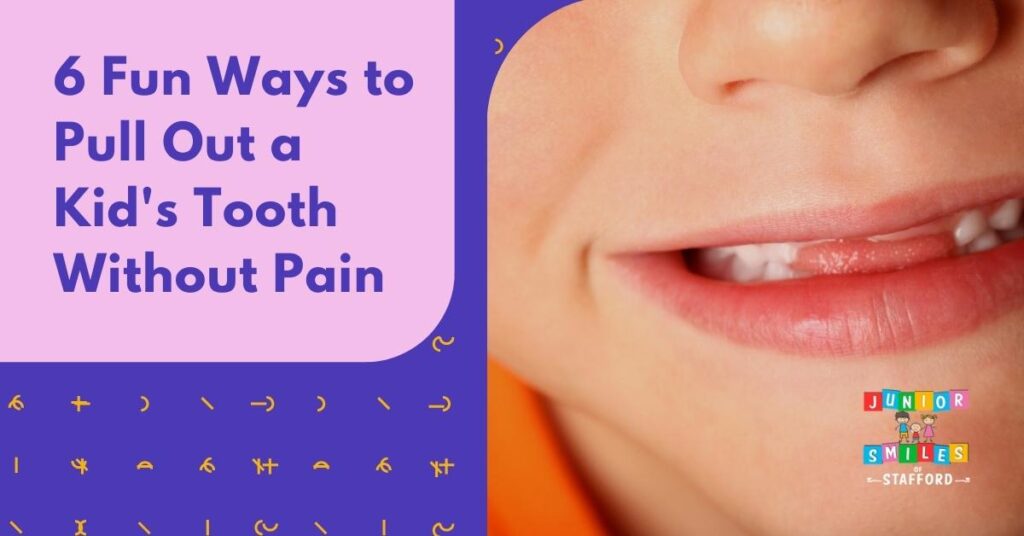6 Fun Ways to Pull Out a Kid’s Tooth Without Pain

Has your child been complaining about their loose tooth over and over again? It’s fun and interesting to see the wobble, the wiggle, the waggle, the first loose baby tooth. It’s a major milestone in any kid’s life, and most of them are incredibly thrilled to experience it. It’s nice to move it back and forth with the tongue, but sooner or later, it will fall out. But the fun doesn’t need to end there.
It’s common for children to lose their “baby teeth” when they transition into adult teeth around the age of 6. It’s common to observe the lower front teeth fall out first, followed by the top two. Typically, some youngsters find the first loose tooth joyful since they’re eager to rid themselves of any traces of their babyhood at that age. That first one, on the other hand, is a little unnerving since they have no idea what to expect when it is out.
And continue reading this blog to learn more about your kid’s loose teeth!
What To Do?
For every child, losing their baby teeth is a rite of passage, and it may really be a pretty joyful experience during their childhood. It’s typical for children to have a wiggly tooth, but they are concerned that the tooth removal would cause too much pain. And as parents, you would want to make sure that your kids feel lesser pain.
The dentist is unnecessary. To create a place for a permanent adult tooth, a baby tooth (also known as primary teeth) is designed to fall out on its own (secondary teeth). This is more common in children between 6 and 7 years old. In addition, parents and their children often have an adventure in tooth pulling; it can also be a way to bond with each other.
However, you should not forcibly remove an adult tooth. Otherwise, you could put your tooth and gum health at risk. Here are the most common dental complications you might experience upon yanking out an adult tooth:
- Receding gumline
- Tooth decay
- Gum infection
- Bone deterioration
- Facial collapse
- Bleeding gums (can be swollen, too)
Pulling Out A Baby Tooth
Baby teeth often fall out on their own. As a matter of fact, you mustn’t remove the baby tooth too early. They aid in developing facial features, including the jaw, by guiding adult teeth into place. However, if the tooth is rotting, make an appointment with your child’s dentist. If you don’t clean or treat your teeth, bacteria and plaque can spread to your kid’s neighboring tooth. Due to the difficulty of brushing them and the larger surface area of primary molars, these teeth are often the first to be removed.
Wiggle The Tooth
Your child is probably playing with their loose tooth using their tongue. That’s totally fine since the tooth will most likely loosen and fall out on its own if you wiggle it back and forth a few times. Just a tip, the looser the tooth is, the lesser the pain there will be.
Remind your youngster to wash their hands first if they insist on wiggling their teeth with their finger. It would be best to stop them from wiggling their tooth using their fingers since this might spread bacteria into the mouth and increase the infection risk.
Eat Crunchy Foods
You may assist loosen your child’s teeth even more by giving them crunchy foods like carrots, apples, and celery to gnaw on! Take the time to remind your youngster not to ingest the tooth. Tell your child to spit the food onto a napkin and then search for the tooth if they think it has come out while chewing. It’s unlikely that your child will suffer any long-term consequences from swallowing the tooth, but it’s important to contact your dentist just in case.
Using String Plus Doorknob
You should tie one end of a rope to one of a doorknob’s screws. Secure the loose tooth with the other end of the string. Close the door, but don’t slam it. The tooth should come out with no problems.
Flossing
Flossing a loose tooth is an excellent technique to get it out. First, wrap 18 inches of floss around each finger. Between thumb and fingers, place the dental floss. Then, floss the loose tooth and its neighbors. Back-and-forth and curl the floss around the loose tooth. You may use a flossing tool for a better grasp.
Twist and Pull
Parents need to remember to be gentle with their children’s teeth when they are loose enough to be taken out. They shouldn’t feel any discomfort when twisting it. If you think your child’s tooth is loose enough to be extracted, use sterile medical gauze to hold it and gently twist it out. Move left-to-right and back-and-forth. This greatly reduces tooth-attaching tissue. If pulling on the tooth harms your kid or if it doesn’t budge with little pressure, don’t pull it yet. Pulling a tooth before it’s ready can be unpleasant and can lead to dental issues.
When NOT To Pull Baby Teeth?
If your child is under 5, the tooth is barely loose, or it’s loose due to an injury or accident, see a dentist. Pulling a tooth before it’s ready might create an open wound, excessive or heavy bleeding, and harm the permanent adult teeth. It can shatter the tooth’s root, creating a space prone to infection and plaque accumulation.
Aftercare Tips
It’s not uncommon for a tooth extraction to be horribly painful. A modest amount of blood is common following a tooth extraction. The tooth fairy can be a great way to distract your child from pain and discomfort. To alleviate pain and discomfort, adhere to these post-surgery instructions.
- Manage blood. Stop the bleeding by applying pressure to the gums using sterile gauze.
- Check for baby tooth fragments. Examine the gums for any fragments of the baby tooth. Call your dentist if you see any residual pieces.
- Treat the area with care. The tooth socket must retain the blood clot that formed after the tooth was extracted to allow the gum to recover correctly.
- Visit your dentist. Take your child to the dentist if they are in discomfort or if you see redness in the gum region.
Read Next: When Should a Child Brush Their Own Teeth?
Contact Junior Smiles of Stafford to learn more about pulling your kid’s baby tooth
If you’re looking for a painless way to pull your child’s tooth, consider using one of the methods we’ve outlined. However, if you have any doubts or concerns, please don’t hesitate to contact the most reputable pediatric dentist in town to have your kid’s dental health checked. We offer the skills and equipment necessary to make your child’s dental appointments joyful and stress-free.
Why Choose Junior Smiles of Stafford?
Our Stafford, VA team is well-versed in working with clients of various ages and backgrounds. They’ll take the time to get to know you and your family’s requirements, and they’ll work with you to design a treatment plan that suits your schedule. Sealants and fluoride treatments are just two of the many preventative care options we provide to keep your mouth healthy.
About Us
Visiting Junior Smiles of Stafford means you’re in good hands when it comes to receiving high-quality care. Your child’s dental health improves with each visit, ensuring a brighter smile for years to come. We adhere to the ADA and AAPD’s guidelines for best practices.
Where Are We Located?
Phone: (540) 699-2441
Fax: (540) 699-2464
Email: info@juniorsmilesofstafford.com
Monday and Tuesday: 9:00 AM – 5:00 PM
Wednesdays and Thursdays: 8:00 AM – 4:00 PM
Fridays and Saturdays: 9:00 AM – 2:00 PM (By appointment only)
How to Book Your Kids First Appointment at Junior Smiles of Stafford
Fill out the form on our website. Within 24 hours, a member of our team will get back to you.

